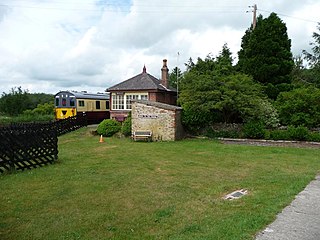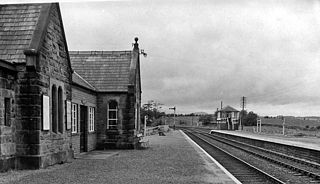The Cockermouth, Keswick and Penrith Railway (CK&PR) was an English railway company incorporated by Act of Parliament on 1 August 1861, to build a line connecting the town of Cockermouth with the London and North Western Railway (LNWR) West Coast Main Line at Penrith. Arrangements for the use of the stations at either end were included. Passenger and goods traffic was worked by the LNWR and mineral traffic by the North Eastern Railway, both of whom had shares in the company. The line was 31+1⁄2 miles (50.7 km) in length, and had eight intermediate stations.

Morfa Mawddach railway station is an unstaffed station located on the outskirts of the village of Arthog in Gwynedd, Wales, on the Cambrian Coast line between Machynlleth and Pwllheli. Built by the Aberystwith and Welsh Coast Railway in 1865, it was formerly the junction station for the Ruabon to Barmouth Line. Since the closure of the Ruabon to Barmouth line in 1965, it remains open, as a minor station on the Cambrian Line.

Bowes railway station was situated on the South Durham & Lancashire Union Railway between Barnard Castle and Kirkby Stephen East.

Warcop railway station was situated on the Eden Valley Railway between Penrith and Kirkby Stephen East. It served the village of Warcop. The station opened to passenger traffic on 9 June 1862, and closed on 22 January 1962. Freight traffic and the occasional troop special continued to use the line through the station until at least May 1987.
Kirkby Thore railway station was a railway station situated on the Eden Valley Railway between Penrith and Kirkby Stephen East. It served the village of Kirkby Thore. The station opened to passenger traffic on 9 June 1862, and closed on 7 December 1953.

Blencow railway station was situated on the Cockermouth, Keswick and Penrith Railway between Penrith and Cockermouth in Cumberland, England. The station served the villages of Blencow and Newbiggin. The station opened to passenger traffic on 2 January 1865, and closed on 3 March 1952. It reopened temporarily on 2 July 1956 before closing permanently on 6 March 1972.
Penruddock railway station was situated on the Cockermouth, Keswick and Penrith Railway between Penrith and Cockermouth in Cumberland, England. The station served the villages of Penruddock and Motherby. The station opened to passenger traffic on 2 January 1865, and closed on 6 March 1972.
Troutbeck railway station was situated on the Cockermouth, Keswick and Penrith Railway between Penrith and Cockermouth in Cumberland, England. The station served the hamlet of Troutbeck. It opened to passenger traffic on 2 January 1865, and closed on 6 March 1972.

Threlkeld railway station was situated on the Cockermouth, Keswick and Penrith Railway between Penrith and Cockermouth in Cumbria, England. The station served the village of Threlkeld. The station opened to passenger traffic on 2 January 1865, and closed on 6 March 1972.

Keswick railway station was on the Cockermouth, Keswick and Penrith Railway between Penrith and Cockermouth in Cumberland, England. It served the town of Keswick and accommodated the offices of the Cockermouth, Keswick and Penrith Railway Company.

Braithwaite railway station was situated on the Cockermouth, Keswick and Penrith Railway between Penrith and Cockermouth in Cumbria, England. The station served the village of Braithwaite.

Embleton railway station was situated on the Cockermouth, Keswick and Penrith Railway between Penrith and Cockermouth in Cumberland, England. The station served the village of Embleton. The station opened to passenger traffic on 2 January 1865, and closed on 15 September 1958.

Cockermouth railway station was situated on the Cockermouth, Keswick and Penrith Railway and served the town of Cockermouth, Cumbria, England.

The original Cockermouth railway station was the eastern terminus of the Cockermouth & Workington Railway. It served the town of Cockermouth, Cumbria, England.

Brigham railway station was situated on the Cockermouth and Workington Railway at its junction with the Maryport and Carlisle Railway's Derwent Branch. It served the village of Brigham, Cumbria, England.

Broughton Cross railway station was situated on the Cockermouth and Workington Railway and served the village of Broughton Cross, Cumbria, England.

Camerton railway station was situated next to the River Derwent on the Cockermouth and Workington Railway. It served the village of Camerton, Cumberland, England.

Workington Bridge railway station was situated at the northern end of Workington Bridge next to the River Derwent, and was originally served by the Cockermouth and Workington Railway, later absorbed by the London and North Western Railway; the road at the north end of the bridge having to be raised to allow the railway to pass under it. It served eastern Workington, Cumberland, England.

Hest Bank railway station was opened by the Lancaster and Carlisle Railway (L&CR) three miles north of Lancaster Castle railway station. The line had been authorised in 1844 and a station was proposed for the village of Hest Bank, Lancashire, the following year. It opened in 1846 along with the line. The station continued to serve the village of Hest Bank until its closure in 1969. The site remains notable as being the point at which the present-day West Coast Main Line (WCML) comes nearest to the west coast. Views of Morecambe Bay can be glimpsed from trains on this section of the line.

Marron Junction railway station was a later addition to the Cockermouth and Workington Railway. It opened on 2 April 1866 with a single, eastbound, platform when the adjacent Marron Junction opened, two months before the company was absorbed by the London and North Western Railway.














